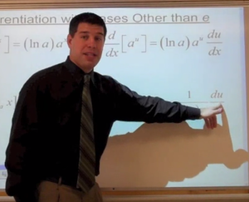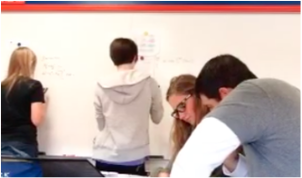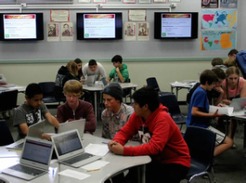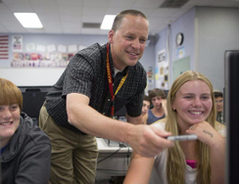by Karen Lien
We know that edtech is most transformative when it's in the hands of great teachers and administrators. I'm continually impressed by the innovative educators we meet who embrace new tech for supporting their students' learning and for managing their schools and classrooms.
Over the next few months, we’ll be publishing a new series on this blog featuring interviews with educators from around the country and highlighting their inspiring examples of edtech in practice. In this first article of the series, we focus on two teachers using technology to flip the learning in their classrooms. (What is flipped learning?) These teachers show us how tech tools can create space for interactive learning and enable deeper relationships between educators and students.
Let’s meet the teachers!
Over the next few months, we’ll be publishing a new series on this blog featuring interviews with educators from around the country and highlighting their inspiring examples of edtech in practice. In this first article of the series, we focus on two teachers using technology to flip the learning in their classrooms. (What is flipped learning?) These teachers show us how tech tools can create space for interactive learning and enable deeper relationships between educators and students.
Let’s meet the teachers!

Introducing Mr. Barber
Bobby Barber teaches math at Millville High School, a Title I school in New Jersey. Mr. Barber’s calculus students have always come to class with lots of thoughtful questions about their homework assignments, but when Mr. Barber was busy introducing new math concepts in class every day, there just wasn’t enough time left to assess every student’s understanding and address all of their questions. That’s why Mr. Barber began flipping his class four years ago, giving the students video lectures to watch at home and focusing on math practice in class. He started off by assigning videos from Khan Academy and Brightstorm, but soon decided to record his own lectures using a simple FlipCam setup in his classroom, eventually building up a library of custom math lessons hosted on EDpuzzle.
Bobby Barber teaches math at Millville High School, a Title I school in New Jersey. Mr. Barber’s calculus students have always come to class with lots of thoughtful questions about their homework assignments, but when Mr. Barber was busy introducing new math concepts in class every day, there just wasn’t enough time left to assess every student’s understanding and address all of their questions. That’s why Mr. Barber began flipping his class four years ago, giving the students video lectures to watch at home and focusing on math practice in class. He started off by assigning videos from Khan Academy and Brightstorm, but soon decided to record his own lectures using a simple FlipCam setup in his classroom, eventually building up a library of custom math lessons hosted on EDpuzzle.

Today, Mr. Barber’s students watch his EDpuzzle lectures at home and answer questions that are embedded directly in the videos. When students walk into class, Mr. Barber already knows what questions they have and which concepts need to be reinforced. EDpuzzle allows him to track which students have watched the videos and see which sections of the video they re-watched, so he knows what they found most confusing. At the beginning of class, he spends only a few minutes at the front of the room clarifying points of general misunderstanding, and then his students break into groups to work through math problems at whiteboards around the room. While students help each other practice new math concepts, Mr. Barber has time to walk around the room to offer guidance, answer questions one on one, and encourage students to push forward. Students who need extra help get the help and support they need, and advanced students are challenged to help their peers. As a result, all of his students are more confident and more successful in their learning.
Introducing Mr. Macfarlane
Matt Macfarlane teaches history at Templeton Middle School, a small, high-performing central California school. A veteran with over 20 years’ teaching experience, Mr. Macfarlane was driven to flip the learning in his classroom because he could see the world changing around his students. Gone are the days when the best memorizers are the most successful students. Today, his kids need to be prepared with a new set of 21st century skills, including problem solving, time management, and collaboration. As he describes it, “I don’t want to spend my precious minutes with students on lecturing. I want to impact my students, which comes when I can interact more with them, when I’m working alongside them and engaging at a deeper level.”
Matt Macfarlane teaches history at Templeton Middle School, a small, high-performing central California school. A veteran with over 20 years’ teaching experience, Mr. Macfarlane was driven to flip the learning in his classroom because he could see the world changing around his students. Gone are the days when the best memorizers are the most successful students. Today, his kids need to be prepared with a new set of 21st century skills, including problem solving, time management, and collaboration. As he describes it, “I don’t want to spend my precious minutes with students on lecturing. I want to impact my students, which comes when I can interact more with them, when I’m working alongside them and engaging at a deeper level.”

To that end, Mr. Macfarlane has transformed his class lectures into media-rich Educreations videos that students can watch at home, thus freeing up all of his class time for interactive learning. In class, students engage in debate, challenge each other’s ideas, and collaborate on projects. Mr. Macfarlane’s classroom is equipped with Chromebooks and a set of big-screen TVs. Students use the Chromebooks to research ideas, gather evidence to support their arguments, and present their work on screens around the room.
“I don’t want to spend my precious minutes with students on lecturing.
I want to impact my students."
Outcomes
Mr. Barber sums up the greatest benefit of his flipped classroom: “Since flipping my class, I get to talk to every single kid every single day.” This has led to deeper relationships with his students, who aren’t afraid to ask questions or make mistakes in class. Students also appreciate the control over their own learning. Busy students can watch when and where they want to, and they can review challenging concepts as many times as needed. On top of all this, Mr. Barber’s students have seen a dramatic improvement in their test scores.
Mr. Barber sums up the greatest benefit of his flipped classroom: “Since flipping my class, I get to talk to every single kid every single day.” This has led to deeper relationships with his students, who aren’t afraid to ask questions or make mistakes in class. Students also appreciate the control over their own learning. Busy students can watch when and where they want to, and they can review challenging concepts as many times as needed. On top of all this, Mr. Barber’s students have seen a dramatic improvement in their test scores.

Since flipping his classroom, Mr. Macfarlane is able to make the most of class time. He finds that his students are better prepared to succeed in class, more excited about learning, and more confident in themselves. With his video presentations, students who need to hear something again can rewind and re-watch, or watch again with a parent, rather than being tethered to the classroom’s pace. All students come to class equipped with the background knowledge they need to successfully participate in class. Students and parents also appreciate that students now spend less time on homework, since they are using class time for guided learning and critical inquiry.
“Since flipping my class, I get to talk to every single kid
every single day.”
So you’re thinking of flipping your classroom…
What advice would Mr. Barber and Mr. Macfarlane offer to anyone thinking about taking the plunge?
What advice would Mr. Barber and Mr. Macfarlane offer to anyone thinking about taking the plunge?
- Try it! Start small, flip one lesson or one chapter. Talk to your students about it, and see what happens!
- Keep your videos short: 10-15 minutes for high school students, 5-10 for middle school, and under 5 for younger students.
- Keep in mind that students may not know how to learn from a video. Watch the first few videos together in class. Show them how to take notes and how to check for their own understanding.
- Give students a deliverable for the next day, even if it’s as simple as a comprehension question.
- Have a back-up plan for students with limited access to online videos. You can provide copies of the videos on DVD or USB drive, or allow time for students to watch at school.
- Reach out to your networks! Both of our featured teachers credit their professional networks with guiding their flipped classroom journeys. Talk to people in your school who have flipped their classrooms, or check out the #flipclass community on Twitter for great advice and support.
Looking ahead
Mr. Macfarlane and Mr. Barber are actively helping other educators in their districts to get started with flipping. What else is ahead for these flipped learning aficionados?
Mr. Barber is experimenting with self-paced learning in his classes. Students have access to all of the video lessons for the entire year, so now his strong students are pushing ahead to challenge themselves with more advanced content, while struggling students focus on mastering each concept before moving forward.
Mr. Macfarlane is experimenting with new tech to support collaboration among his students. He’s also making plans to connect them with other classrooms around the country for geography scavenger hunts!
Mr. Macfarlane and Mr. Barber are actively helping other educators in their districts to get started with flipping. What else is ahead for these flipped learning aficionados?
Mr. Barber is experimenting with self-paced learning in his classes. Students have access to all of the video lessons for the entire year, so now his strong students are pushing ahead to challenge themselves with more advanced content, while struggling students focus on mastering each concept before moving forward.
Mr. Macfarlane is experimenting with new tech to support collaboration among his students. He’s also making plans to connect them with other classrooms around the country for geography scavenger hunts!
Dive Deeper
Learn more about Mr. Barber’s and Mr. Macfarlane’s flipped classrooms.
Watch Mr. Macfarlane introduce the Bill of Rights on Educreations.
Watch Mr. Barber’s calculus lesson on EDpuzzle.
Connect with Mr. Barber @MillvilleAPCalc & Mr. Macfarlane @mrmacsclasses.
Learn more about Mr. Barber’s and Mr. Macfarlane’s flipped classrooms.
Watch Mr. Macfarlane introduce the Bill of Rights on Educreations.
Watch Mr. Barber’s calculus lesson on EDpuzzle.
Connect with Mr. Barber @MillvilleAPCalc & Mr. Macfarlane @mrmacsclasses.
Have you flipped your classroom?
Tweet your flipped class stories and tips to @imaginek12 #flipclass.
Tweet your flipped class stories and tips to @imaginek12 #flipclass.

 RSS Feed
RSS Feed